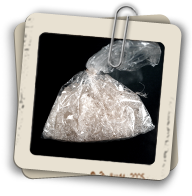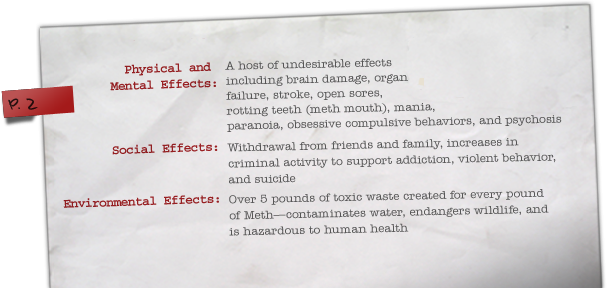The Drug Defined



What's In Meth
 Acetone
Nail polish remover or paint thinner. Extremely flammable. In the setting of a Meth lab where Meth is being cooked with high heat, acetone is very dangerous.
Acetone
Nail polish remover or paint thinner. Extremely flammable. In the setting of a Meth lab where Meth is being cooked with high heat, acetone is very dangerous. Lithium
Used in batteries. Lithium seriously burns the skin upon contact. It also reacts violently with water and is highly explosive.
Lithium
Used in batteries. Lithium seriously burns the skin upon contact. It also reacts violently with water and is highly explosive. Toluene
Used in brake fluid. Toluene is powerful enough to dissolve rubber.
Toluene
Used in brake fluid. Toluene is powerful enough to dissolve rubber. Hydrochloric
Hydrochloric
AcidUsed to make plastic. It can remove rust from steel and is highly corrosive to human skin. In high concentrations, hydrochloric acid will literally eat away human flesh. Pseudoephedrine
Decongestant found in cold medicine. Large amounts of pseudoephedrine on its own can harm the respiratory and nervous systems, as well as the heart.
Pseudoephedrine
Decongestant found in cold medicine. Large amounts of pseudoephedrine on its own can harm the respiratory and nervous systems, as well as the heart. Red
Red
PhosphorusFound on matchboxes, in road flares, and other explosives. Ignites when overheated. Sodium
Sodium
HydroxideLye. Can burn the skin or cause blindness. It’s used to dispose of road kill because it turns the dead bodies into a coffee-like liquid. Sulfuric
Sulfuric
AcidUsed in drain or toilet bowl cleaner. Another highly corrosive substance that burns the skin on contact. Anhydrous
Anhydrous
AmmoniaFound in fertilizer or countertop cleaner. On its own, it has a pungent, suffocating odor; mixing it with other chemicals can release highly toxic gases.
Terms
-
A poisonous substance that affects the central nervous system and damages nervous tissue. Over time, Meth can damage the brain’s dopamine neurons—important for reward, motivation, and learning. Brain Damage
-
Any chemical substance, like methamphetamine, that acts on the central nervous system, changing the way the brain functions.
-
Commonly called an “upper,” it is a substance that causes increased alertness or physical activity. A stimulant like Meth first elevates mood and energy, then leads to rebound depression and anxiety. Comparing Highs
-
A man-made compound created by a chemical process. Methamphetamine is not a naturally occurring substance and is synthesized by combining various toxic chemicals. Home “cooks” prepare Meth in makeshift labs, hotel rooms, trailers, even the back seat of a car. Shopping List















